Reconnaissance of the Effects of the MW5.7 (ML6.4) Jajarkot Nepal Earthquake of 3 November 2023, Post-Earthquake Responses, and Associated Lessons to Be Learned
Abstract
:1. Introduction
2. Ground Motion and Seismo-Tectonic Aspects
3. Building Damage Assessment
3.1. Building Typology and Design Codes in Nepal
3.2. Residential Buildings
3.2.1. RC-Framed Buildings
3.2.2. Masonry Buildings
3.3. Heritage Structures
3.4. Public Buildings
4. Seismically Induced Geotechnical Impacts
5. Critical Infrastructures
5.1. Bridges
5.2. Communication Structures
5.3. Dams and Water Structures
6. Post Disaster Responses
6.1. Intermediate Shelters and Reconstruction
6.2. Challenges
6.2.1. Socio-Economic Challenges
6.2.2. Building-Reconstruction Challenges
7. Conclusions and Lessons Learned
- This study revealed that most of the buildings were non-engineered. It also showed that there were no substantial initiatives taken to implement the code in the region.
- The level of damage in RC structures is comparatively lower than that in masonry buildings, potentially due to the lower intensity of ground shaking. However, the damage observed in these non-engineered RC structures stems from irregular structural configuration, inadequate design and detailing, and the use of substandard construction materials and practices. Addressing these issues underscores the need for a regulatory framework from the government to ensure earthquake resistance in the built environment.
- The damage to masonry buildings resulted from factors such as inadequate construction detailing, subpar masonry material properties, irregularly shaped stones with smooth surfaces, weak structural walls, unconfined gable walls, and cracks at the corners of windows and doors. Implementing minimum reinforcement measures, such as through stones in the walls or horizontal and vertical bands, proved to be effective in enhancing the seismic performance of masonry buildings.
- In contrast, stone masonry structures in a Sherpa village near the epicenter showed enhanced stability, attributed to the addition of timber bands at various levels, underscoring the significance of thoughtful architectural elements in earthquake-prone regions.
- The earthquake significantly impacted the education sector, with 898 school buildings affected, causing disruptions for 125,000 students and highlighting the urgent need for reconstruction and support.
- The earthquake resulted in extensive destruction in mountainous areas, triggering minor to major landslides that, at times, blocked roads and isolated villages. Strengthening Nepal’s local transportation network is essential to enhancing the resilience of rural communities.
- Rockfalls, landslides, and road damage were evident, underscoring the significance of implementing effective landslip mitigation techniques, robust road design, and the necessity for targeted strategies in earthquake-prone areas.
- Regardless of earthquake magnitude and intensity, seismo-induced environmental effects such as landslides, rockfall, ground subsidence, and fissures can significantly impact the assessment of seismic hazards by altering the dynamic response of structures and terrain. These effects can pose challenges in accurately predicting ground motion and structural behavior, influencing the seismic vulnerability of a region. Consequently, post-reconstruction efforts must consider these environmental factors to enhance resilience and mitigate potential seismic risks effectively.
- Strict adherence to mandatory rules of thumb (MRT) and building code implementation are essential, along with the provision of technical support for new construction. Standard practices for earthquake safety should be widely disseminated in a format that is easily accessible and actionable at the implementation level.
- A sufficient and reliable network of strong ground motion instruments should be installed so that a comprehensive study of ground motion and the response of structures can be known for the study of what structures can be designed for those areas.
- In Himalayan terrain, the construction of new unreinforced masonry (URM) structures should be prohibited, and retrofitting measures for critical, lifeline, and government structures should be enforced.
- The present study and research are mostly focused on advancing construction material types and technology. However, to ensure sustainability and preserve traditional technology, it is now also necessary to redirect our research efforts towards our indigenous technology and methodologies.
- Many affected areas lack accessibility to market areas, making the transportation of construction materials such as cement, reinforcement bars, and aggregate challenging. Promoting local building technology in Nepal not only preserves the rich history of Nepali construction but also showcases resilience to various weather conditions, ensuring cultural preservation and adaptability to diverse environments. This enhances scenic aesthetics, addresses economic and transportation aspects by boosting the regional economy, reducing reliance on external resources, and promoting sustainability in building methodologies. Additionally, involving the local community in the empowerment process through training and awareness is essential. Without this local engagement, disaster risk reduction or resilience efforts may remain mere slogans on paper, destined for ineffectiveness.
- Mobilizing post-earthquake damage assessment teams with impartial judgment on the usability of damaged structures is crucial. Additionally, technical information should be disseminated to professional architects and engineers regarding accepted methods for the assessment and retrofit of damaged structures, utilizing the experience gained from the 2015 Gorkha earthquake.
- Further, disaster reconstruction should adopt flexible designs adaptable to diverse contexts, considering geographical, cultural, and socioeconomic variations. Prioritizing social equity is crucial to ensuring inclusive support for vulnerable groups. This approach enhances reconstruction effectiveness, fosters resilience, and promotes long-term community well-being.
Author Contributions
Funding
Data Availability Statement
Acknowledgments
Conflicts of Interest
References
- USGS. M5.7-44 km E of Dailekh, Nepal; United States Geological Survey: Reston, VA, USA, 2023.
- Ader, T.; Avouac, J.P.; Liu-Zeng, J.; Lyon-Caen, H.; Bollinger, L.; Galetzka, J.; Genrich, J.; Thomas, M.; Chanard, K.; Sapkota, S.N.; et al. Convergence rate across the Nepal Himalaya and interseismic coupling on the Main Himalayan Thrust: Implications for seismic hazard. J. Geophys. Res. Solid Earth. 2012, 117, B4. [Google Scholar] [CrossRef]
- Paudyal, H.; Shanker, D.; Singh, H.; Panthi, A.; Kumar, A.; Singh, V. Current understanding of the seismotectonics of Western Nepal Himalaya and vicinity. Acta Geod. Geophys. Hung. 2010, 45, 195–209. [Google Scholar] [CrossRef]
- Angster, S.; Fielding, E.J.; Wesnousky, S.; Pierce, I.; Chamlagain, D.; Gautam, D.; Upreti, B.N.; Kumahara, Y.; Nakata, T. Field reconnaissance after the 25 April 2015 M 7.8 Gorkha earthquake. Seismol. Res. Lett. 2015, 86, 1506–1513. [Google Scholar] [CrossRef]
- UNICEF. UNICEF Nepal Humanitarian Situation Report No. 3 (Earthquake): 20 November 2023. 2023. Available online: https://reliefweb.int/report/nepal/unicef-nepal-humanitarian-situation-report-no-3-earthquake-20-november-2023 (accessed on 1 December 2023).
- Goda, K.; Kiyota, T.; Pokhrel, R.M.; Chiaro, G.; Katagiri, T.; Sharma, K.; Wilkinson, S. The 2015 Gorkha Nepal Earthquake: Insights from Earthquake Damage Survey. Front. Built Environ. 2015, 1, 8. [Google Scholar] [CrossRef]
- Sharma, K.; Deng, L.; Noguez, C.C. Field investigation on the performance of building structures during the April 25, 2015, Gorkha earthquake in Nepal. Eng. Struct. 2016, 121, 61–74. [Google Scholar] [CrossRef]
- Subedi, M.; KC, R.; Acharya, I.P. SPT-based seismic soil liquefaction potential evaluation of Kathmandu Valley using first-order second-moment method. In Proceedings of the GeoNiagara Conference 2021, Niagara Falls, ON, Canada, 26–29 September 2021. [Google Scholar]
- Acharya, I.P.; Subedi, M.; KC, R. Liquefaction Hazard Assessment of Kathmandu Valley Using Deterministic and Probabilistic Approaches. In Proceedings of the Geo-Risk 2023, Arlington, VA, USA, 23–26 July 2023; pp. 307–317. [Google Scholar] [CrossRef]
- Gautam, D.; Chaulagain, H. Structural performance and associated lessons to be learned from world earthquakes in Nepal after 25 April 2015 (MW 7.8) Gorkha earthquake. Eng. Fail. Anal. 2016, 68, 222–243. [Google Scholar] [CrossRef]
- Sharma, K.; Deng, L. Reconnaissance Report on Geotechnical Engineering Aspect of the 2015 Gorkha, Nepal, Earthquake. J. Earthq. Eng. 2017, 23, 512–537. [Google Scholar] [CrossRef]
- Kc, A.; Sharma, K.; Pokharel, B. Performance of Heritage Structures during the Nepal Earthquake of April 25, 2015. J. Earthq. Eng. 2017, 23, 1346–1384. [Google Scholar] [CrossRef]
- Sharma, K.; Deng, L.; Khadka, D. Reconnaissance of liquefaction case studies in 2015 Gorkha (Nepal) earthquake and assessment of liquefaction susceptibility. Int. J. Geotech. Eng. 2017, 13, 326–338. [Google Scholar] [CrossRef]
- Rai, D.C.; Singhal, V.; Raj S, B. Reconnaissance of the effects of the M7.8 Gorkha (Nepal) earthquake of April 25, 2015. Geomat. Nat. Hazards Risk 2016, 7, 1–17. [Google Scholar] [CrossRef]
- Hashash, Y.M.; Tiwari, B.; Moss, R.E.S.; Asimaki, D.; Clahan, K.B.; Kieffer, D.S.; Dreger, D.S.; Macdonald, A.; Madugo, C.M.; Mason, H.B.; et al. Geotechnical Field Reconnaissance: Gorkha (Nepal) Earthquake of April 25, 2015 and Related Shaking Sequence; Geotechnical Extreme Event Reconnaisance GEER Association Report No. GEER-040, August 2015. Available online: https://digitalcommons.calpoly.edu/cenv_fac/311 (accessed on 5 December 2023).
- Okamura, M.; Bhandary, N.P.; Mori, S.; Marasini, N.; Hazarika, H. Report on a reconnaissance survey of damage in Kathmandu caused by the 2015 Gorkha Nepal earthquake. Soils Found. 2015, 55, 1015–1029. [Google Scholar] [CrossRef]
- Ghazoui, Z.; Bertrand, S.; Vanneste, K.; Yokoyama, Y.; Nomade, J.; Gajurel, A.P.; van der Beek, P.A. Potentially large post-1505 AD earthquakes in western Nepal revealed by a lake sediment record. Nat. Commun. 2019, 10, 2258. [Google Scholar] [CrossRef] [PubMed]
- Srivastava, H.; Verma, M.; Bansal, B.; Sutar, A.K. Discriminatory characteristics of seismic gaps in Himalaya. Geomat. Nat. Hazards Risk 2013, 6, 224–242. [Google Scholar] [CrossRef]
- Koukouvelas, I.K.; Nikolakopoulos, K.G.; Kyriou, A.; Caputo, R.; Belesis, A.; Zygouri, V.; Verroios, S.; Apostolopoulos, D.; Tsentzos, I. The March 2021 Damasi Earthquake Sequence, Central Greece: Reactivation Evidence across the Westward Propagating Tyrnavos Graben. Geosciences 2021, 11, 328. [Google Scholar] [CrossRef]
- Mercimek, Ö. Seismic failure modes of masonry structures exposed to Kahramanmaraş earthquakes (Mw 7.7 and 7.6) on February 6, 2023. Eng. Fail. Anal. 2023, 151, 107422. [Google Scholar] [CrossRef]
- Markušić, S.; Stanko, D.; Korbar, T.; Belić, N.; Penava, D.; Kordić, B. The Zagreb (Croatia) M5.5 Earthquake on 22 March 2020. Geosciences 2020, 10, 252. [Google Scholar] [CrossRef]
- Sharma, K.; Subedi, M.; Acharya, I.P.; Pokharel, B. Geotechnical and Structural Aspect of 2015 Gorkha Nepal Earthquake and Lesson Learnt. J. Inst. Eng. 2018, 13, 20–36. [Google Scholar] [CrossRef]
- Sharma, K.; Subedi, M.; Parajuli, R.R.; Pokharel, B. Effects of surface geology and topography on the damage severity during the 2015 Nepal Gorkha earthquake. Lowl. Technol. Int. 2017, 18, 4. [Google Scholar]
- Subedi, M.; Sharma, K.; Acharya, I.P.; Adhikari, K. Liquefaction of soil in Kathmandu Valley from 2015 Gorkha, Nepal. Nepal Eng. Assoc. Tech. J. Spec. Issue Gorkha Earthq. 2018, 2015, 108–116. [Google Scholar]
- Chiaro, G.; Kiyota, T.; Pokhrel, R.M.; Goda, K.; Katagiri, T.; Sharma, K. Reconnaissance report on geotechnical and structural damage caused by the 2015 Gorkha Earthquake, Nepal. Soils Found. 2015, 55, 1030–1043. [Google Scholar] [CrossRef]
- Avouac, J.-P.; Meng, L.; Wei, S.; Wang, T.; Ampuero, J.-P. Lower edge of locked Main Himalayan Thrust unzipped by the 2015 Gorkha earthquake. Nat. Geosci. 2015, 8, 708–711. [Google Scholar] [CrossRef]
- NBC 105:2020; Seismic Design of Buildings in Nepal. Nepal Government: Kathmandu, Nepal, 2020.
- Nepal Engineers’ Association. Seismicity and Seismotectonic related to Jajarkot Earthquake 2023′, a Lecture by Dr. Lok Bijaya Adhikari on December 8, 2023. 2023. Available online: https://www.youtube.com/watch?v=RjmdY_Ph5Uk (accessed on 9 December 2023).
- CBS. National Population and Housing Census 2021; National Report; National Statistics Office: Kathmandu, Nepal, 2021.
- Chaulagain, H.; Gautam, D.; Rodrigues, H. Revisiting Major Historical Earthquakes in Nepal: Overview of 1833, 1934, 1980, 1988, 2011, and 2015 Seismic Events. In Impacts and Insights of the Gorkha Earthquake; Elsevier: Amsterdam, The Netherlands, 2018; pp. 1–17. [Google Scholar] [CrossRef]
- Arendt, L.; Hortacsu, A.; Jaiswal, K.; Bevington, J.; Shrestha, S.; Lanning, F.; Mentor-William, G.; Naeem, G.; Thibert, K.; Arendt, A.M.L.; et al. Implementing Nepal’s National Building Code: A Case Study in Patience and Persistence. Earthq. Spectra 2017, 33, 167–183. [Google Scholar] [CrossRef]
- Ozcan, O.; Binici, B.; Ozcebe, G. Improving seismic performance of deficient reinforced concrete columns using carbon fiber-reinforced polymers. Eng. Struct. 2008, 30, 1632–1646. [Google Scholar] [CrossRef]
- Mercimek, Ö.; Ghoroubi, R.; Özdemir, A.; Anil, Ö.; Erbaş, Y. Investigation of strengthened low slenderness RC column by using textile reinforced mortar strip under axial load. Eng. Struct. 2022, 259, 114191. [Google Scholar] [CrossRef]
- Gautam, D.; Chettri, N.; Tempa, K.; Rodrigues, H.; Rupakhety, R. Seismic vulnerability of bhutanese vernacular stone masonry buildings: From damage observation to fragility analysis. Soil Dyn. Earthq. Eng. 2022, 160, 107351. [Google Scholar] [CrossRef]
- Michetti, A.M.; Esposito, E.; Guerrieri, L.; Porfido, S.; Serva, L.; Tatevossian, R.; Vittori, E.; Audemard, F.; Azuma, T.; Clague, J.; et al. Environmental Seismic Intensity Scale-ESI 2007. 2007. Available online: https://www.academia.edu/27126998/A_M_Michetti_E_Esposito_L_Guerrieri_S_Porfido_L_Serva_R_Tatevossian_E_Vittori_F_Audemard_T_Azuma_J_Clague_V_Comerci_A_G%C3%BCrpinar_J_MCCALPIN_B_MOHAMMADIOUN_N_A_M%C3%B6rner_Y_Ota_E_ROGHOZIN (accessed on 10 December 2023).
- KC, R.; Sharma, K.; Dahal, B.K.; Aryal, M.; Subedi, M. Study of the spatial distribution and the temporal trend of landslide disasters that occurred in the Nepal Himalayas from 2011 to 2020. Environ. Earth Sci. 2023, 83, 1–18. [Google Scholar] [CrossRef]
- KC, R.; Aryal, M.; Dahal, B.K.; Sharma, K. Spatial and Temporal Analysis of Landslides during Last Decade in Nepal. In Proceedings of the 10th IOE Graduate Conference, Lalitpur, Nepal, 10–11 October 2021; pp. 102–106. Available online: https://www.researchgate.net/publication/358987469_Spatial_and_Temporal_Analysis_of_Landslides_during_Last_Decade_in_Nepal (accessed on 22 November 2023).
- Naik, S.P.; Kim, Y.-S.; Kim, T.; Su-Ho, J. Geological and Structural Control on Localized Ground Effects within the Heunghae Basin during the Pohang Earthquake (MW 5.4, 15th November 2017), South Korea. Geosciences 2019, 9, 173. [Google Scholar] [CrossRef]
- Joshi, M.; Naik, S.P.; Mohanty, A.; Bhadran, A.; Girishbai, D.; Ghosh, S. First hand observations from the April 28, 2021 Sonitpur (MW 6.4) earthquake, Assam, India: Possible mechanism involved in the occurrence of widespread ground effects. Geosci. J. 2023, 27, 225–239. [Google Scholar] [CrossRef]
- Kim, Y.-S.; Naik, S.P.; Choi, J.-H.; Jin, K.; Ho, G.-R.; Kim, T.; Lee, J. Kinematic analysis and fault-dependence of building-wall fracture patterns during moderate earthquakes. Geosci. J. 2023, 27, 769–780. [Google Scholar] [CrossRef]
- Barakat, S. Housing Reconstruction after Conflict and Disaster; Overseas Development Institute: London, UK, 2003. [Google Scholar]
- Tierney, K.; Oliver-Smith, A. Social Dimensions of Disaster Recovery. Int. J. Mass Emergencies Disasters 2012, 30, 123–146. [Google Scholar] [CrossRef]
- Nepal Human Development Report. 2014. Available online: https://www.undp.org/nepal/publications/nepal-human-development-report-2014 (accessed on 10 December 2023).
- Shrestha, K.K.; Bhattarai, B.; Ojha, H.R.; Bajracharya, A. Disaster justice in Nepal’s earthquake recovery. Int. J. Disaster Risk Reduct. 2018, 33, 207–216. [Google Scholar] [CrossRef]
- Tafti, M.T.; Tomlinson, R. Long-term socio-spatial transformation of earthquake-affected neighborhoods in Bhuj: Who stayed, who left and who moved in? Int. J. Disaster Resil. Built. Environ. 2016, 7, 230–258. [Google Scholar] [CrossRef]
- Lam, L.M. Against the trend: Evaluation of Nepal’s owner-driven reconstruction program. Housing. Studies 2023, 1–28. [Google Scholar] [CrossRef]
- Mumtaz, H.; Mughal, S.H.; Stephenson, M.; Bothara, J.K. The challenges of reconstruction after the October 2005 Kashmir earthquake. Bull. N. Zldn. Soc. Earthq. Eng. 2008, 41, 68–82. [Google Scholar] [CrossRef]
- Sharma, K.; Kc, A.; Subedi, M.; Pokharel, B. Challenges for reconstruction after Mw7.8 Gorkha earthquake: A study on a devastated area of Nepal. Geomat. Nat. Hazards Risk 2018, 9, 760–790. [Google Scholar] [CrossRef]
- Sharma, K.; Kc, A.; Subedi, M.; Pokharel, B. Post Disaster Reconstruction after 2015 Gorkha Earthquake: Challenges and Influencing Factors. J. Inst. Eng. 2018, 14, 52–63. [Google Scholar] [CrossRef]
- Acharya, P.; Sharma, K.; Pokharel, G.R.; Adhikari, R. Managing Postdisaster Reconstruction after the 2015 Gorkha, Nepal Earthquake and Lessons Learned. Nat. Hazards Rev. 2022, 23, 04022029. [Google Scholar] [CrossRef]
- Acharya, P.; Sharma, K.; Pokharel, G.R.; Adhikari, R. Reviewing the progress of reconstruction five years after the 2015 Gorkha earthquake, Nepal. Build. Res. Inf. 2022, 50, 595–609. [Google Scholar] [CrossRef]
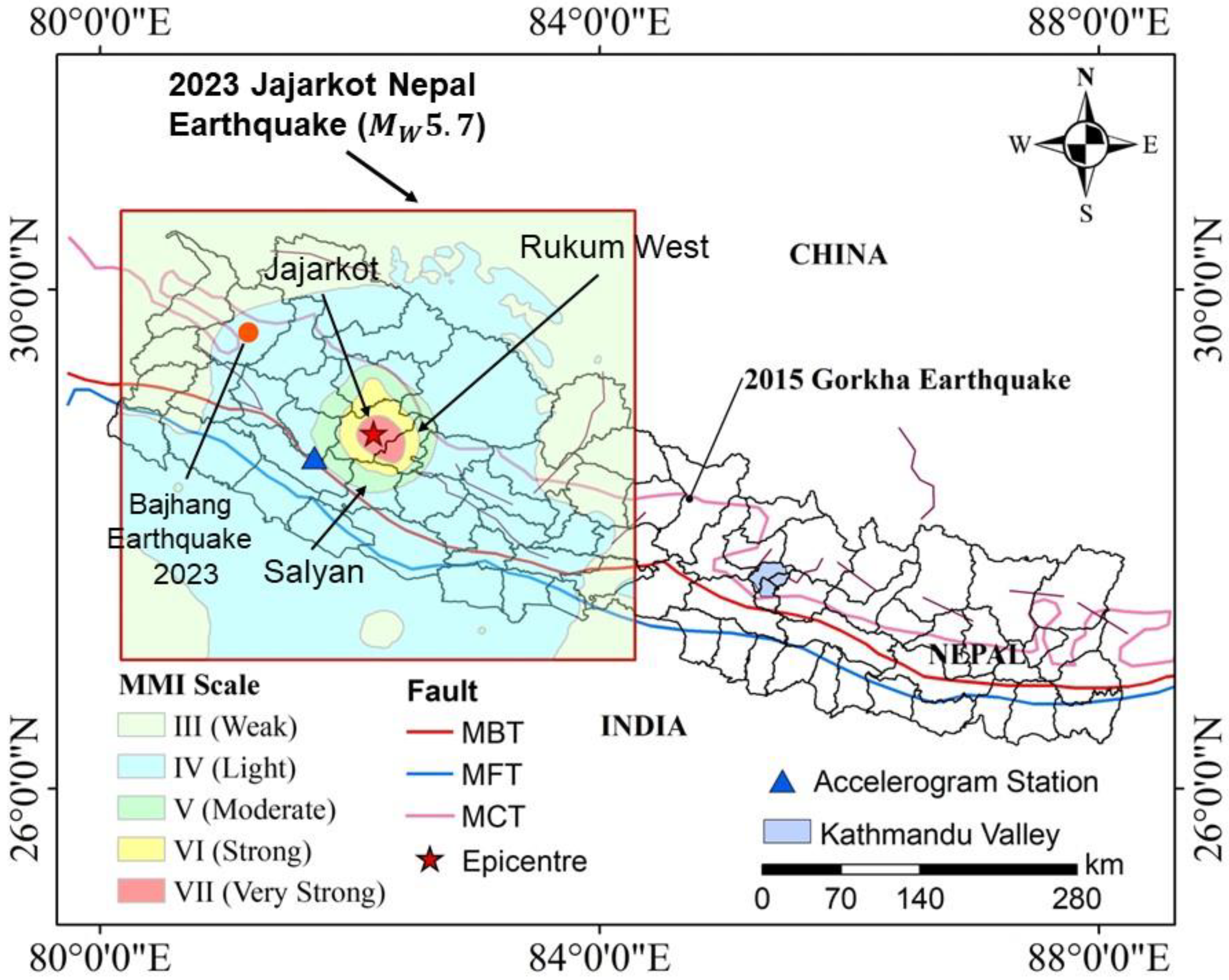
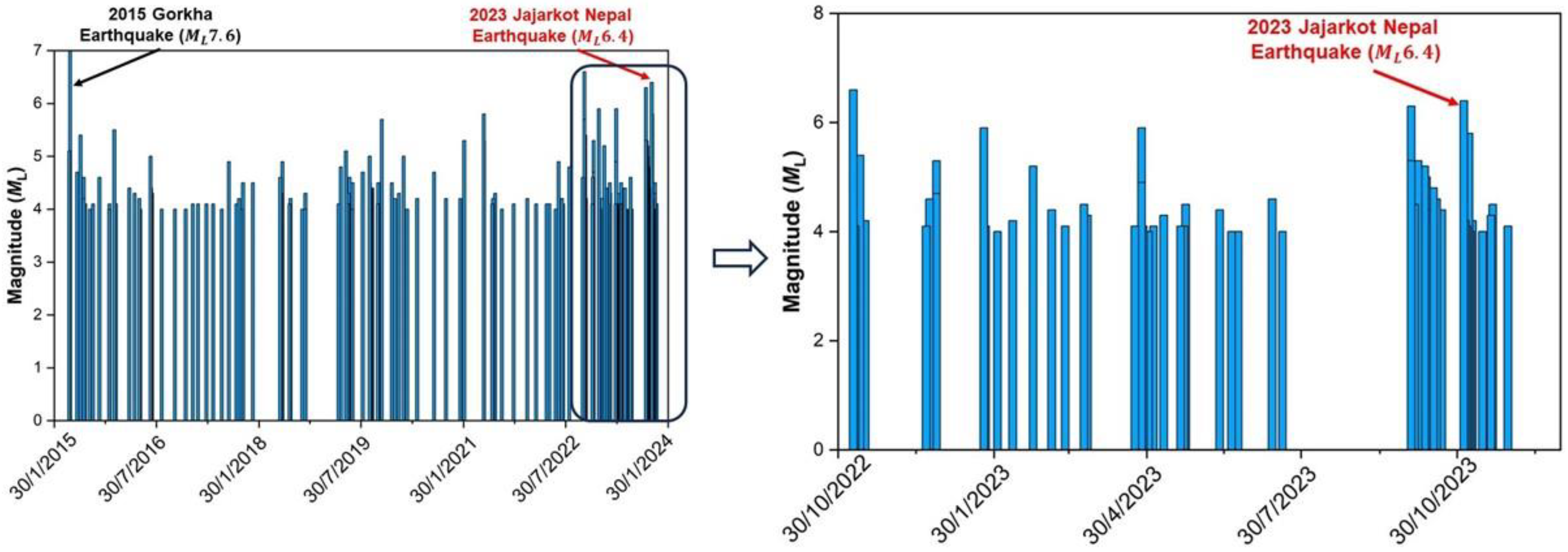

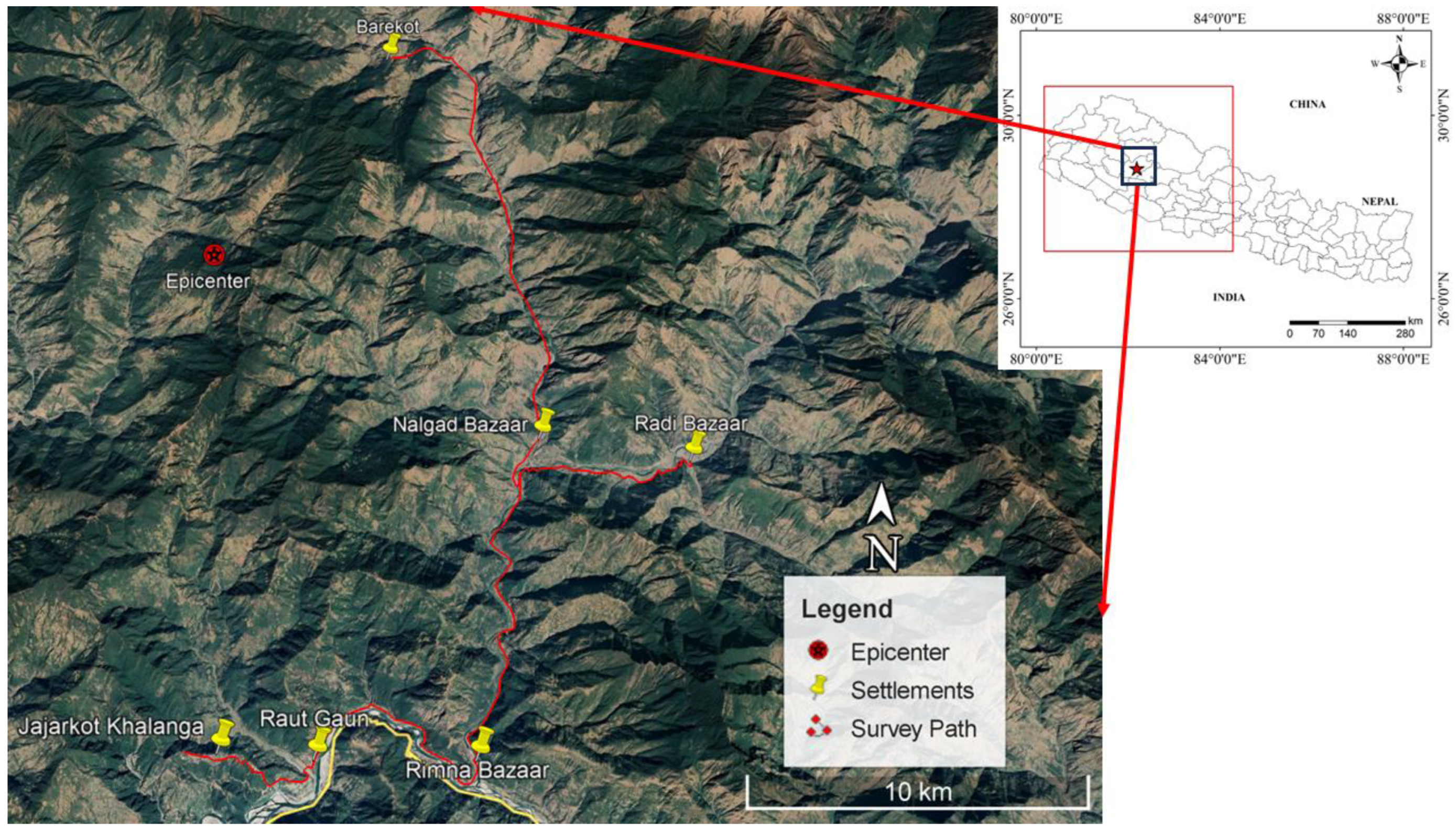


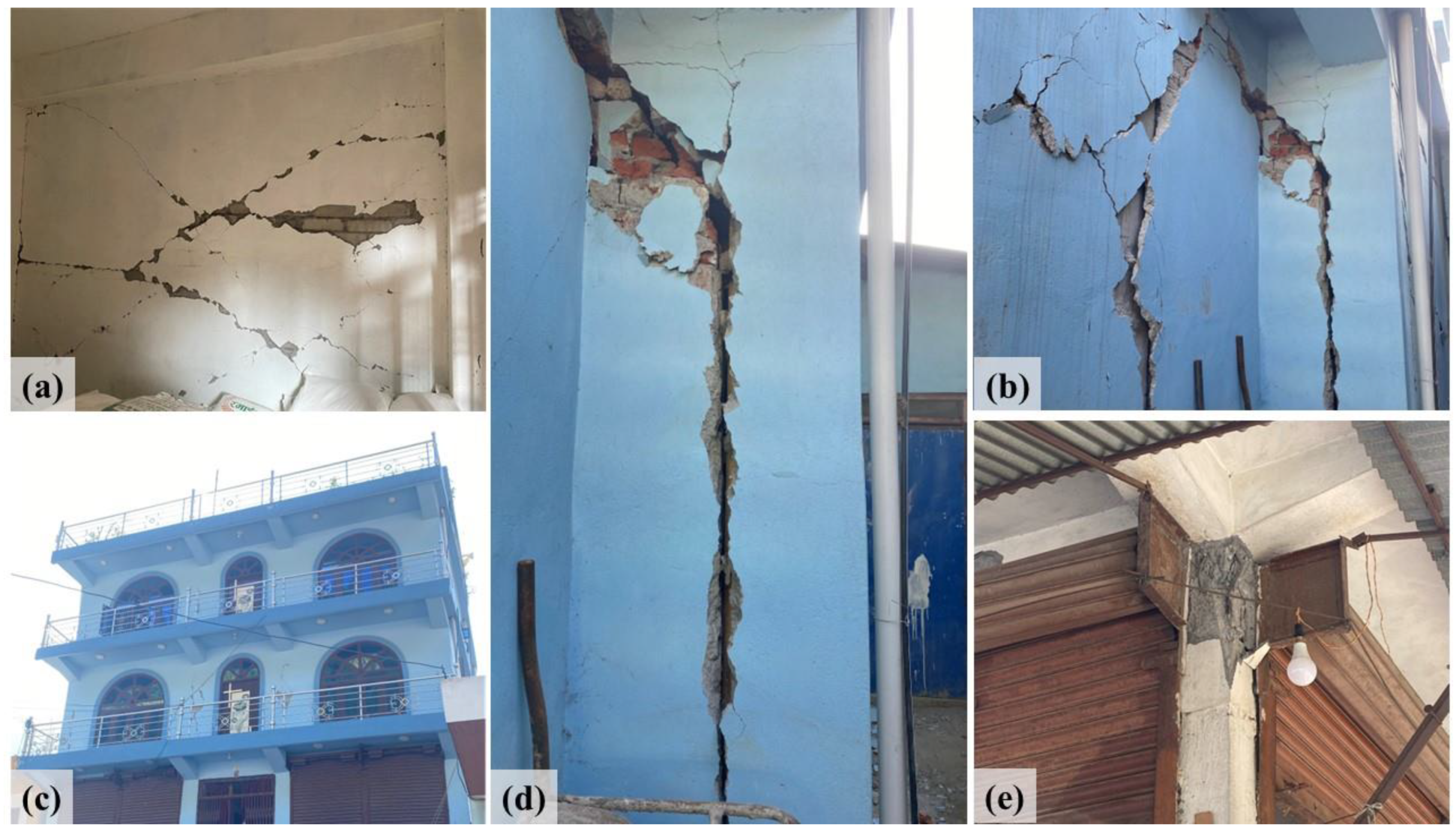
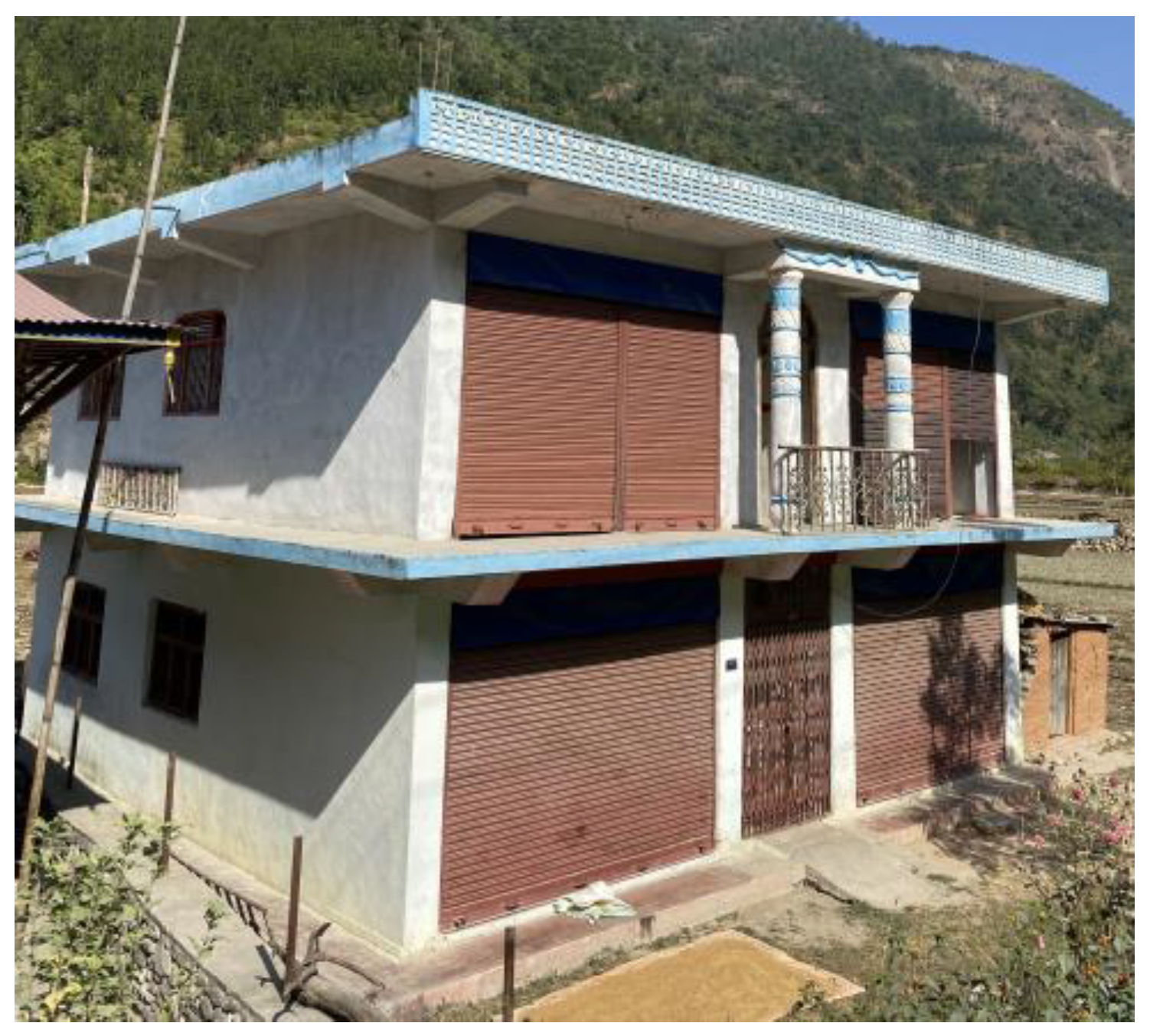

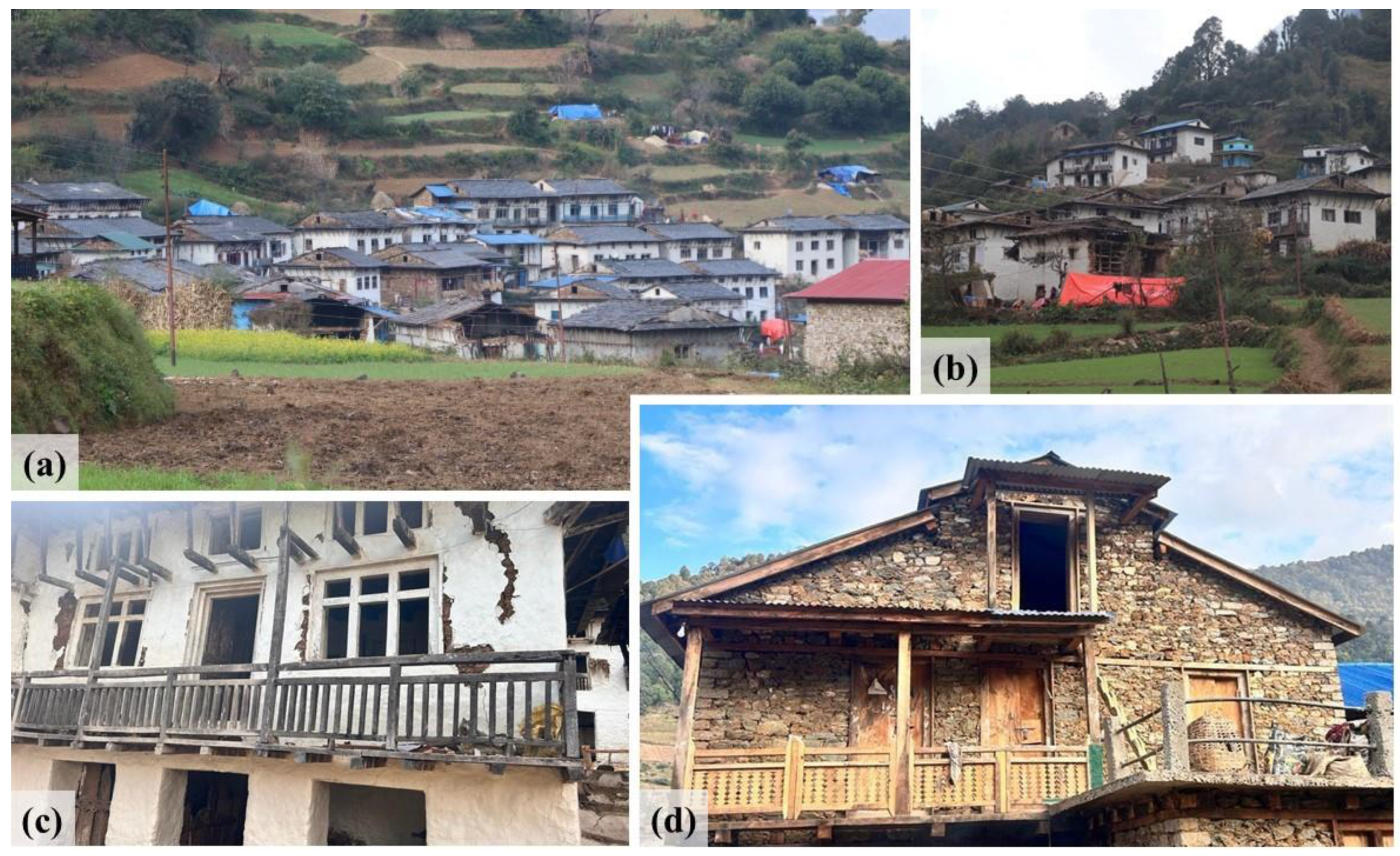
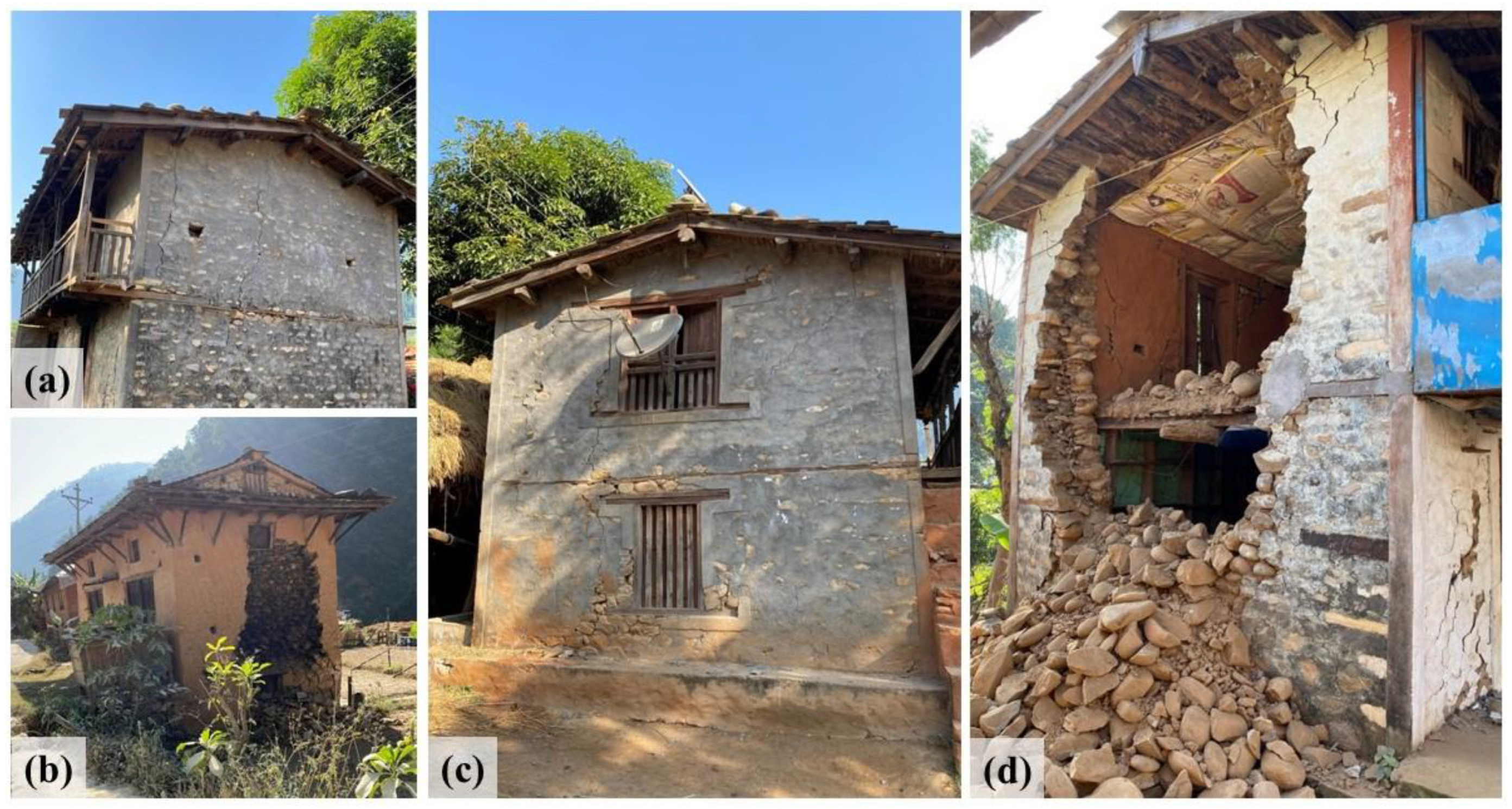
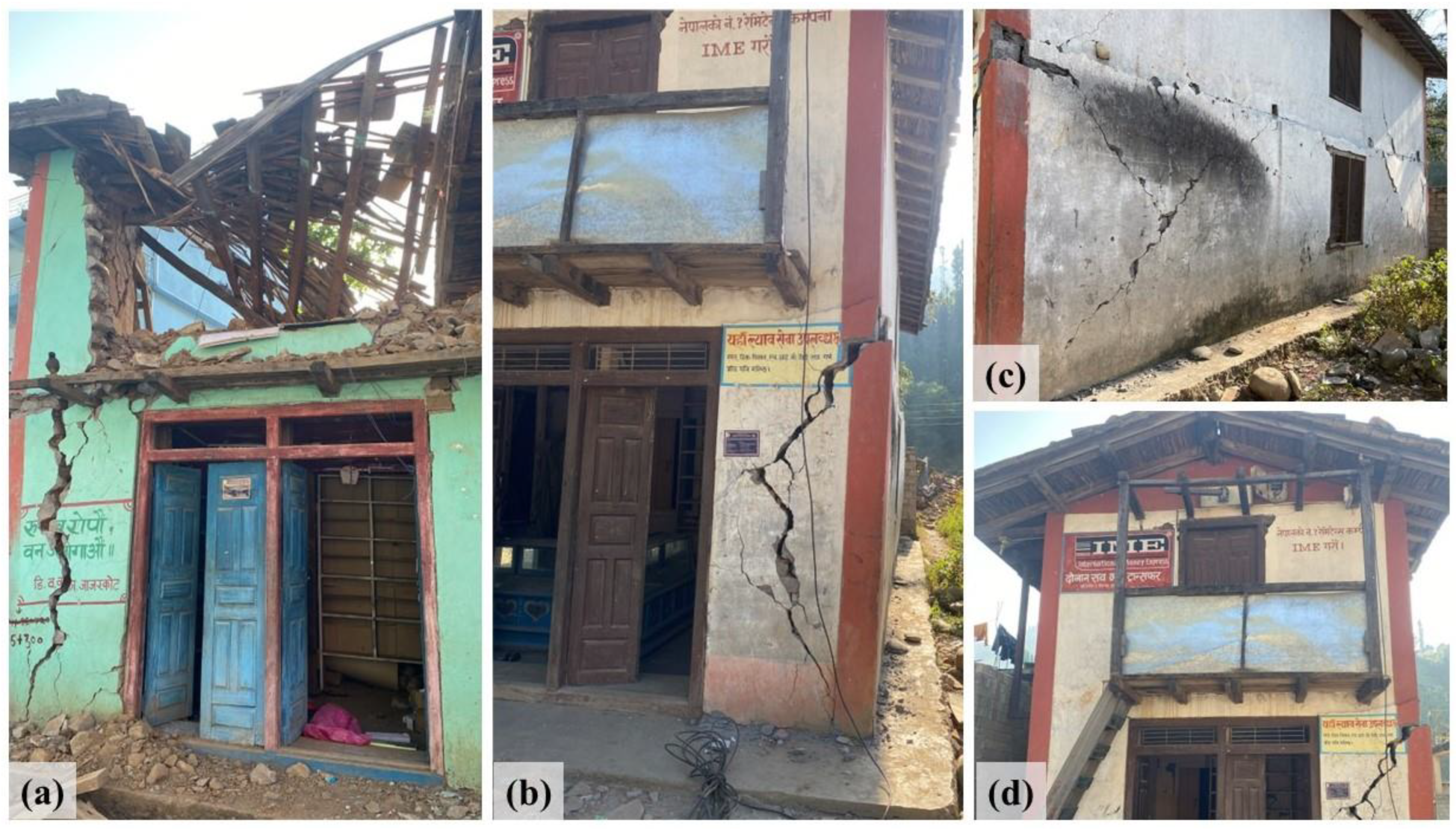
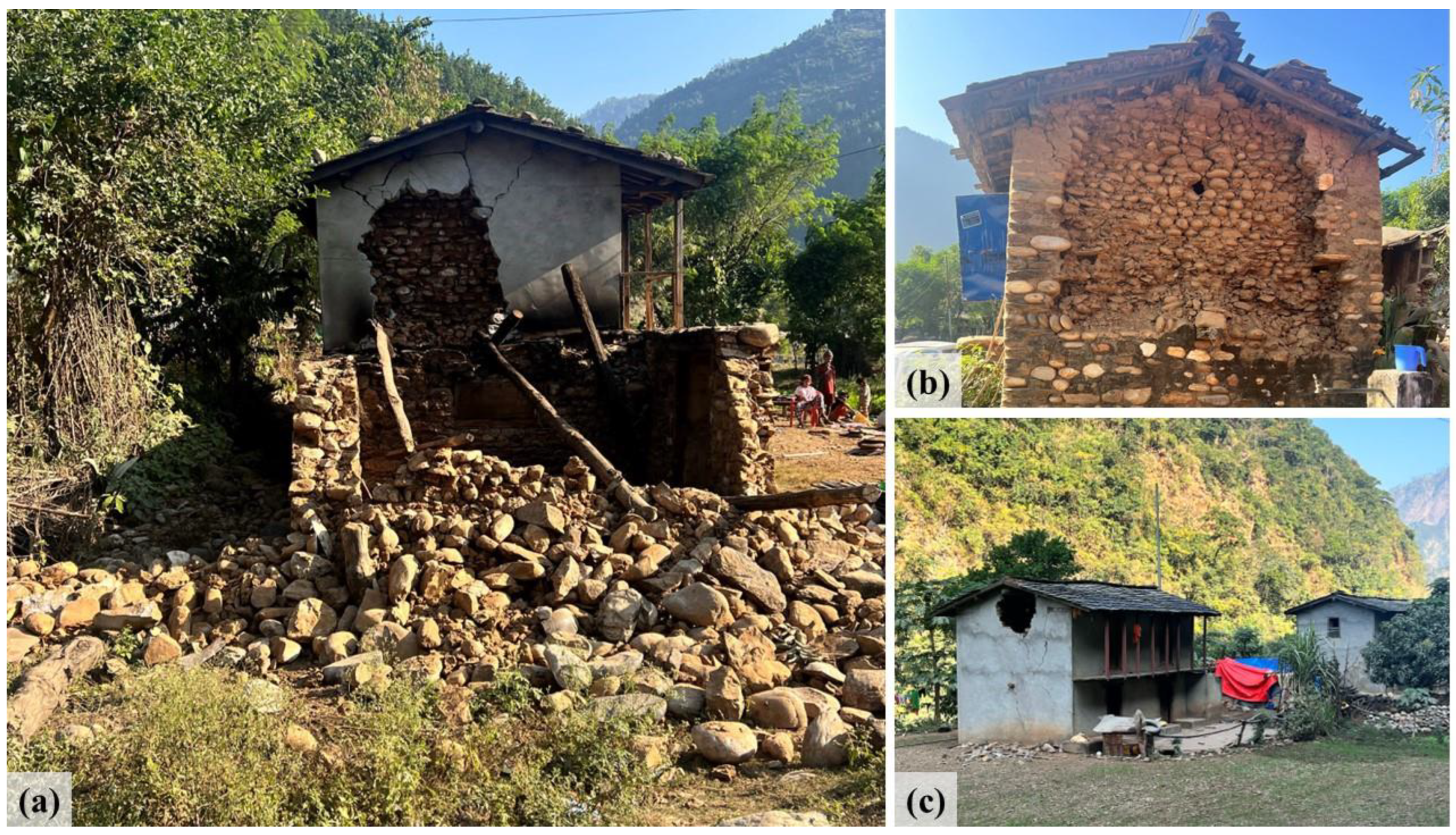
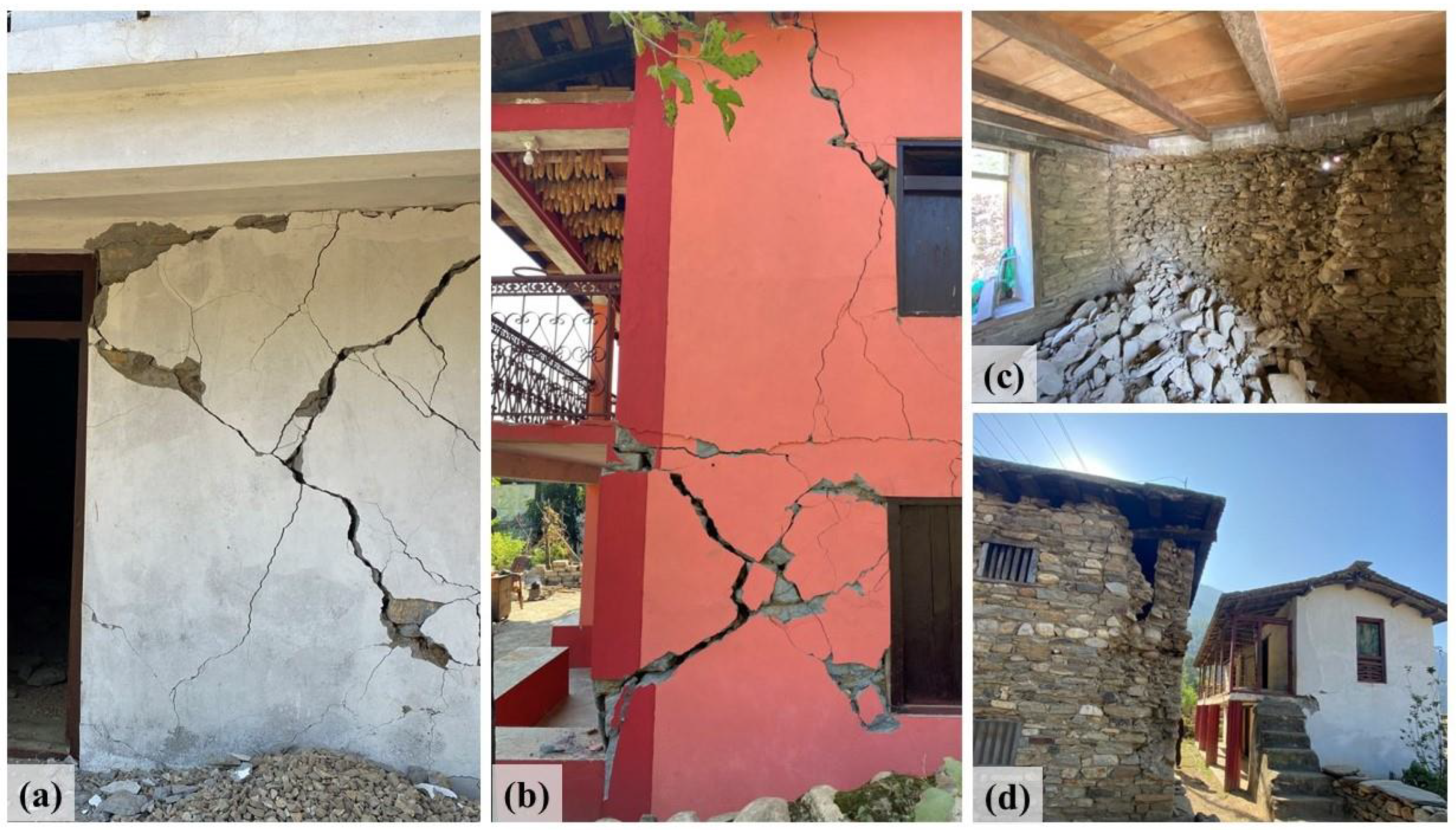


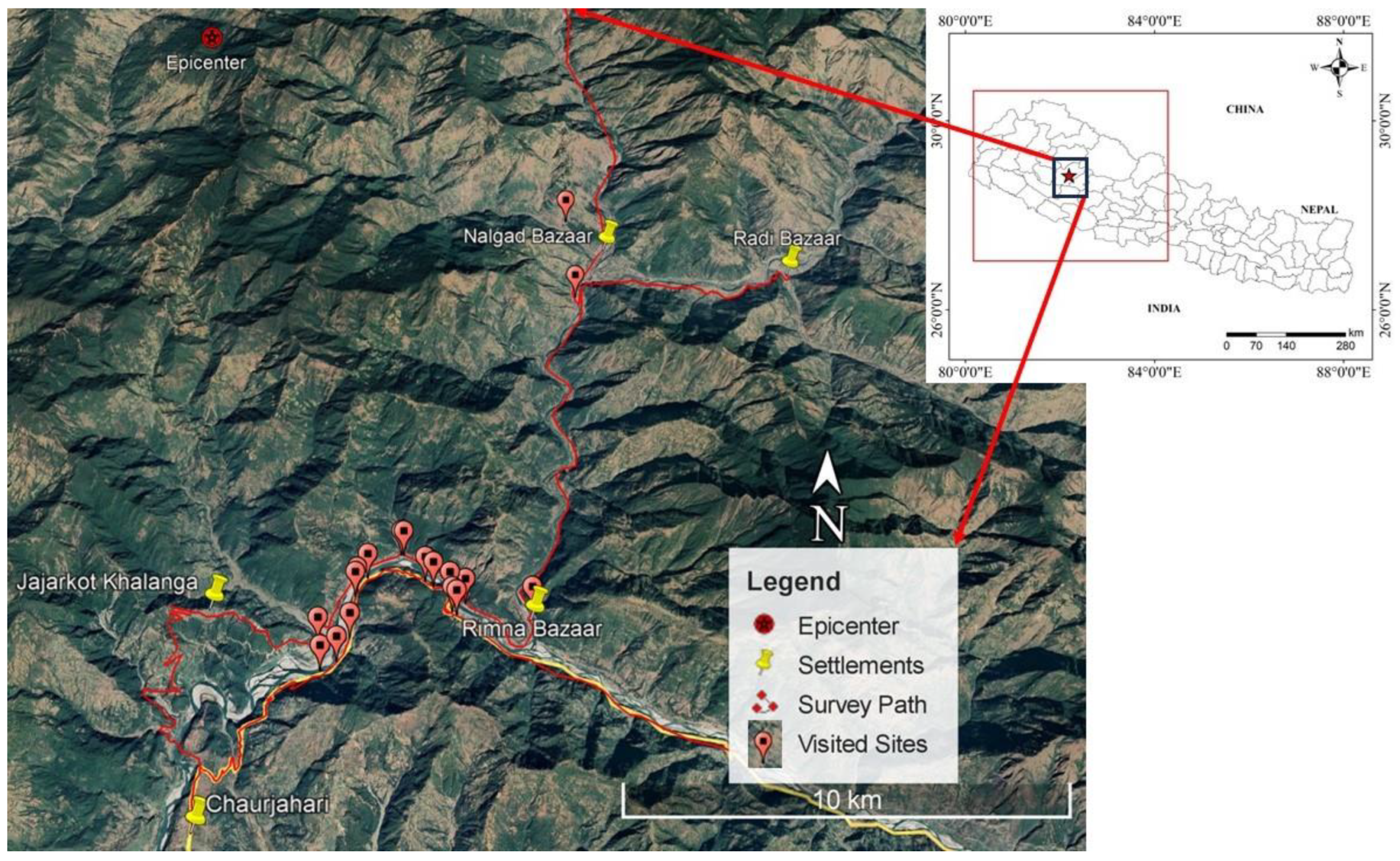
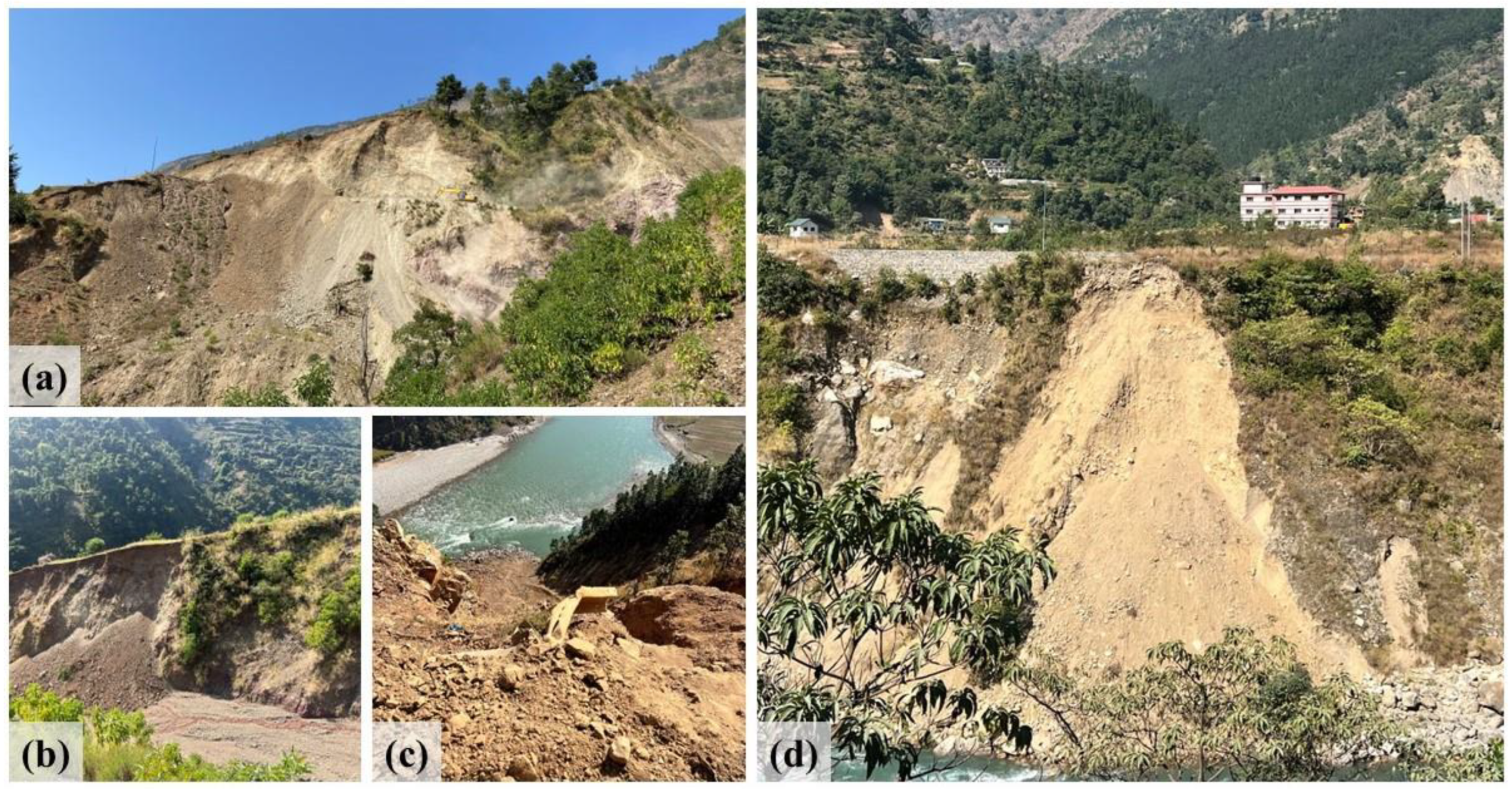
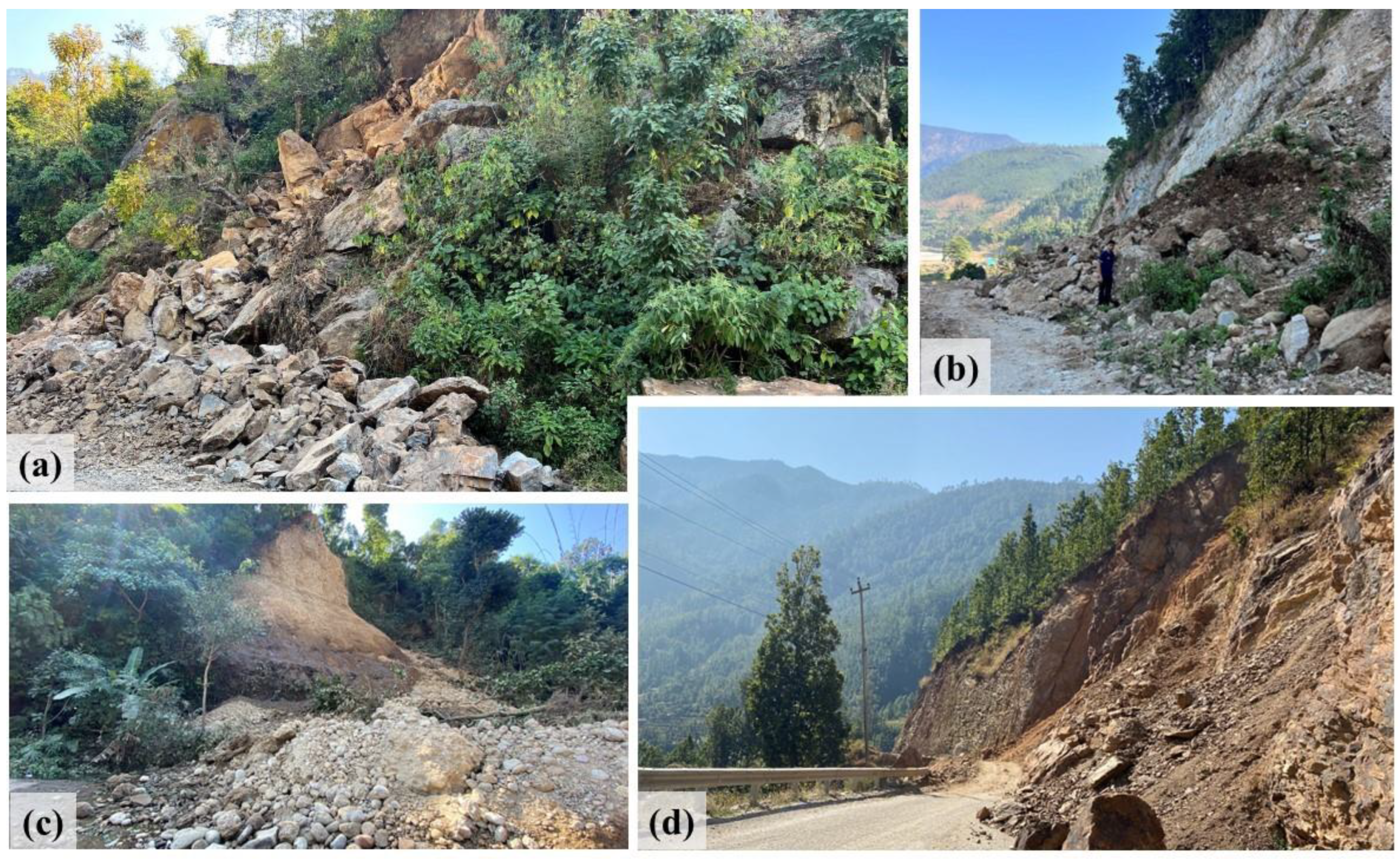
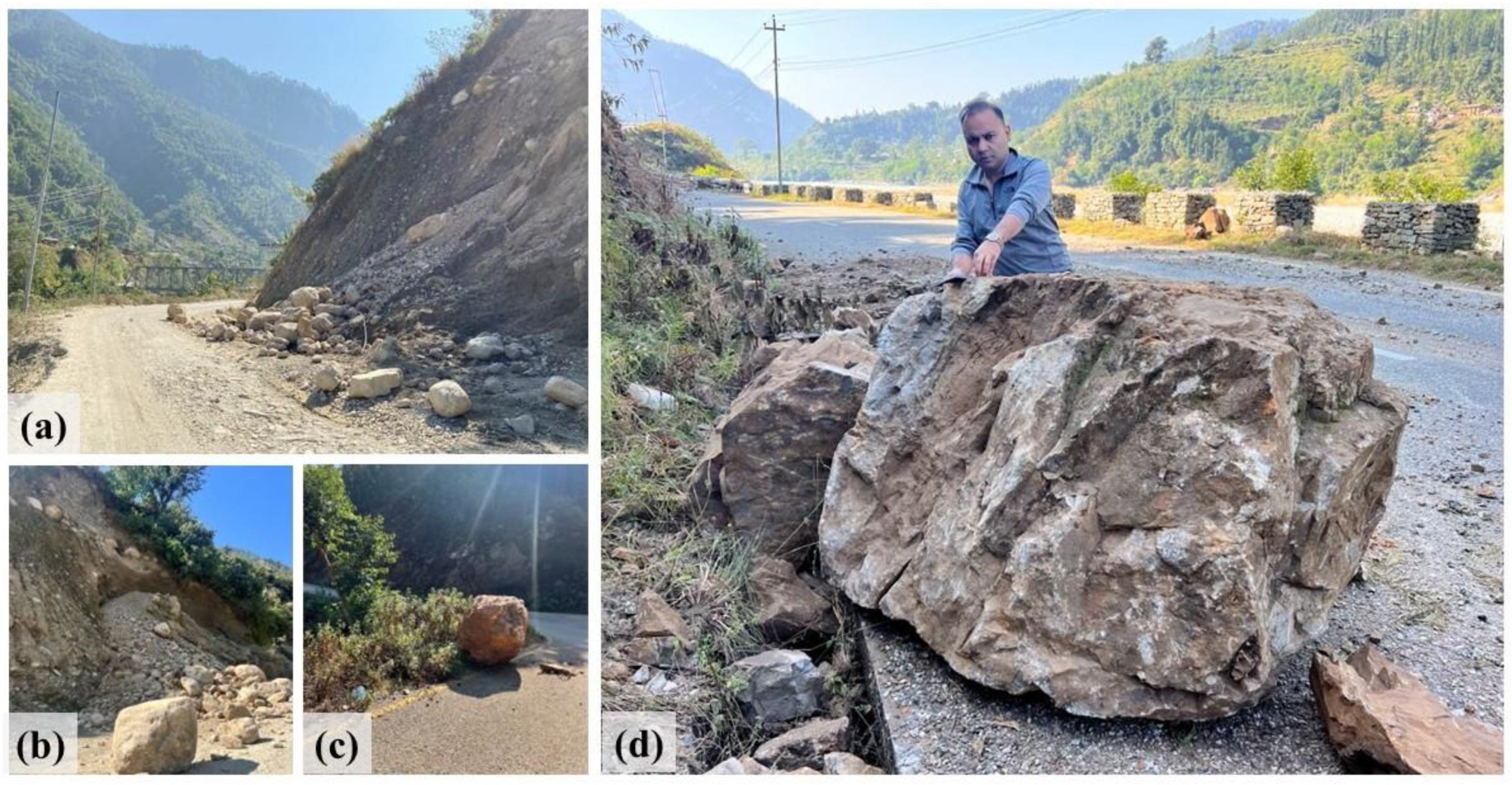
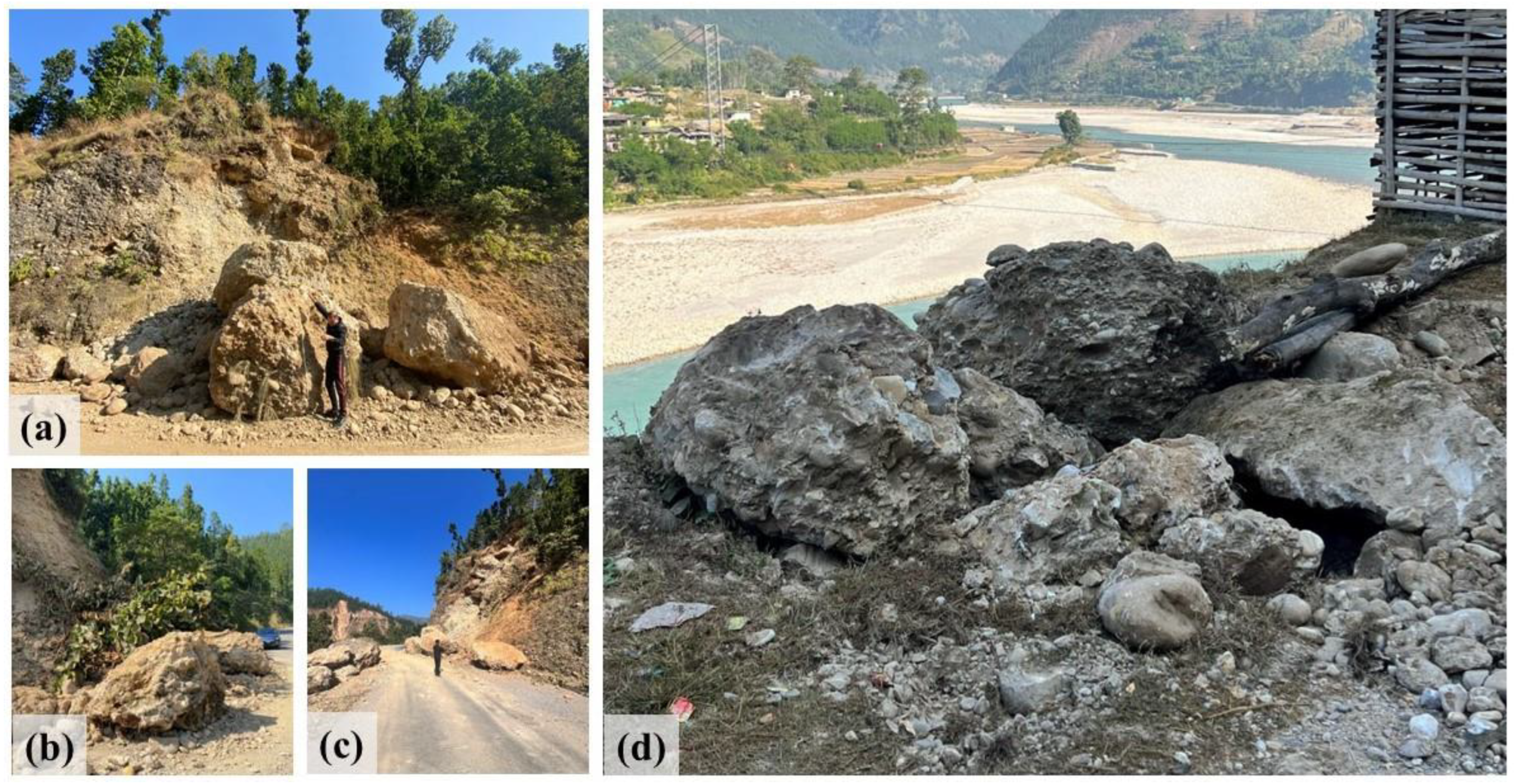
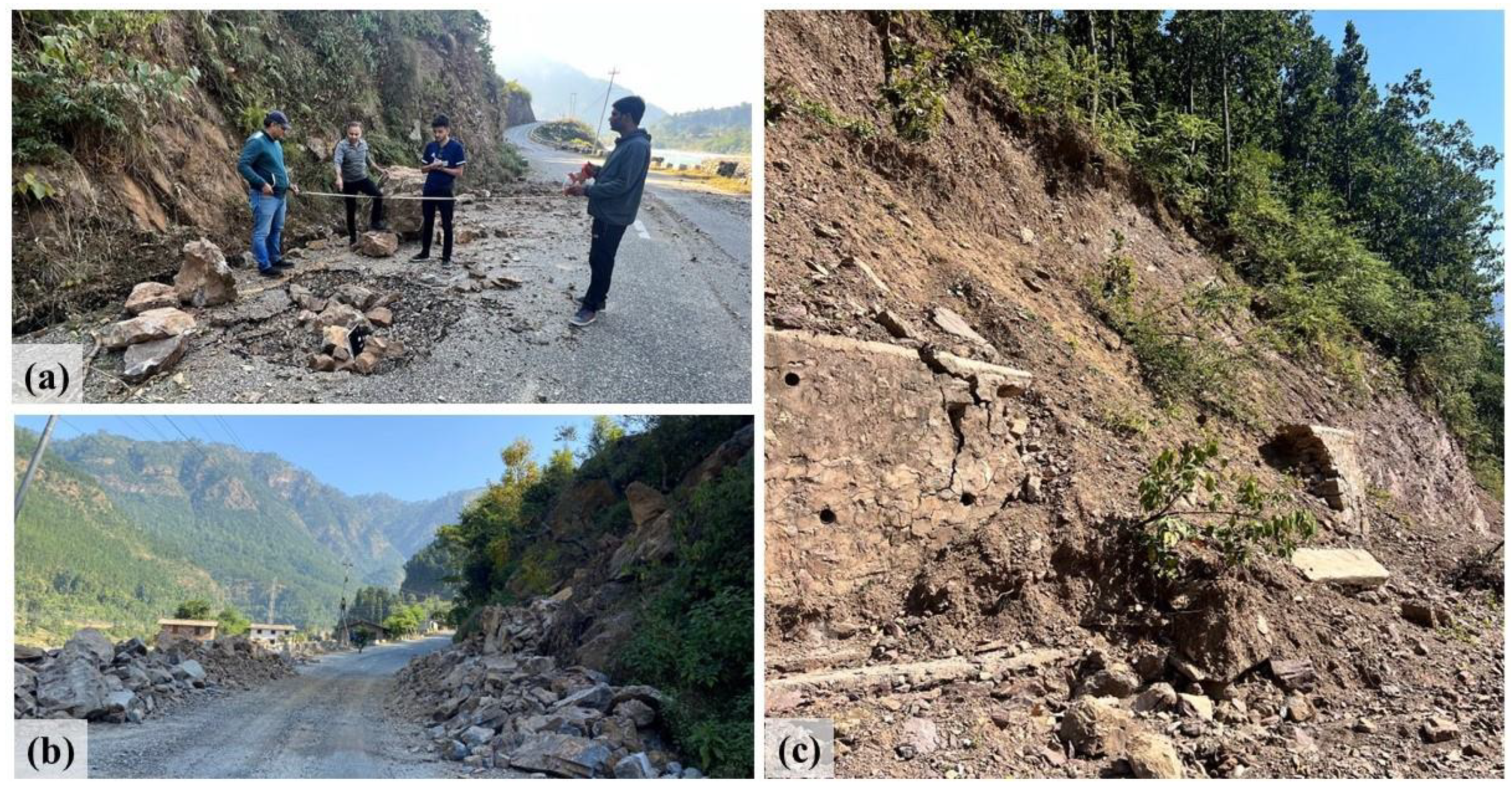


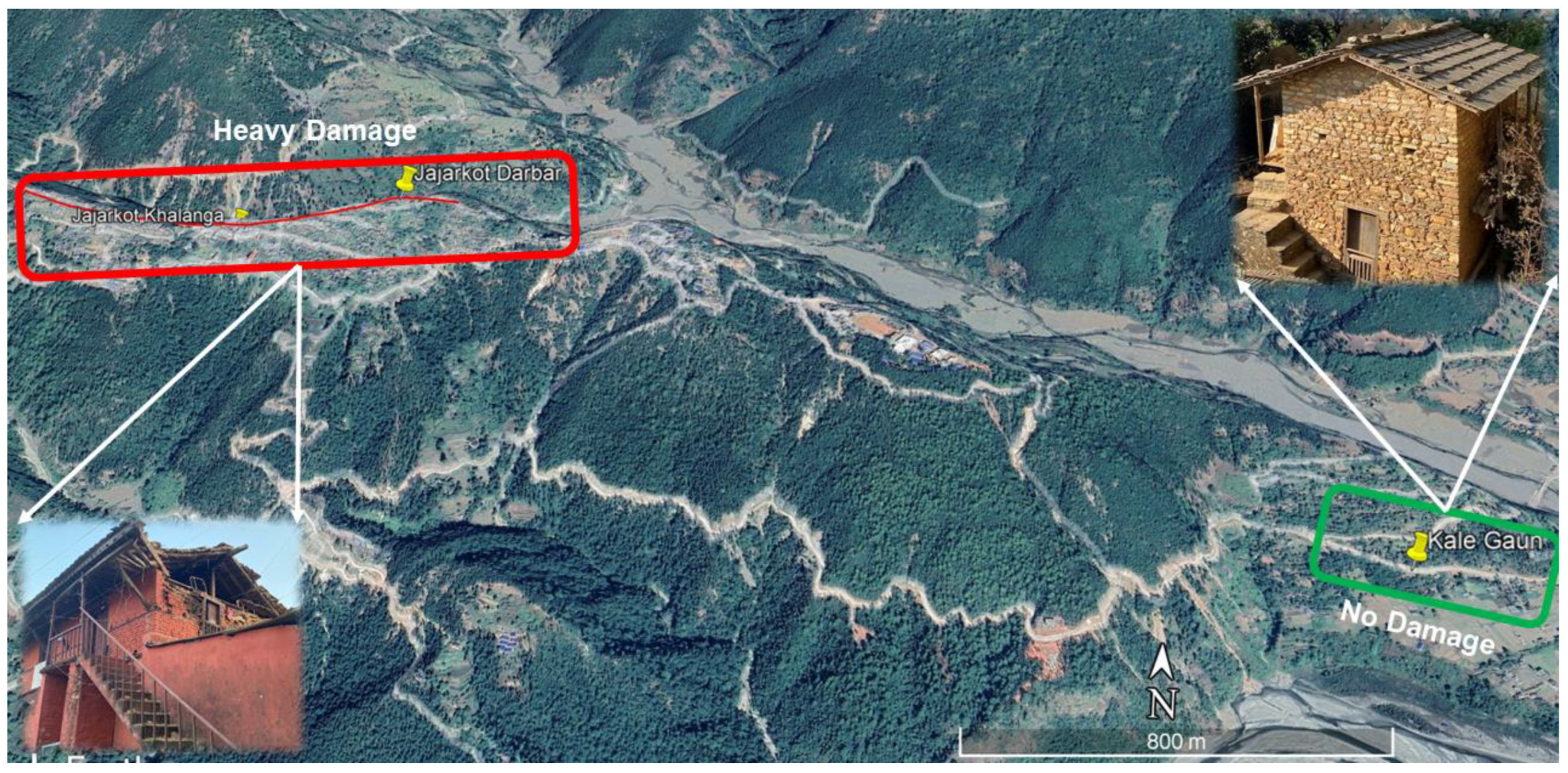
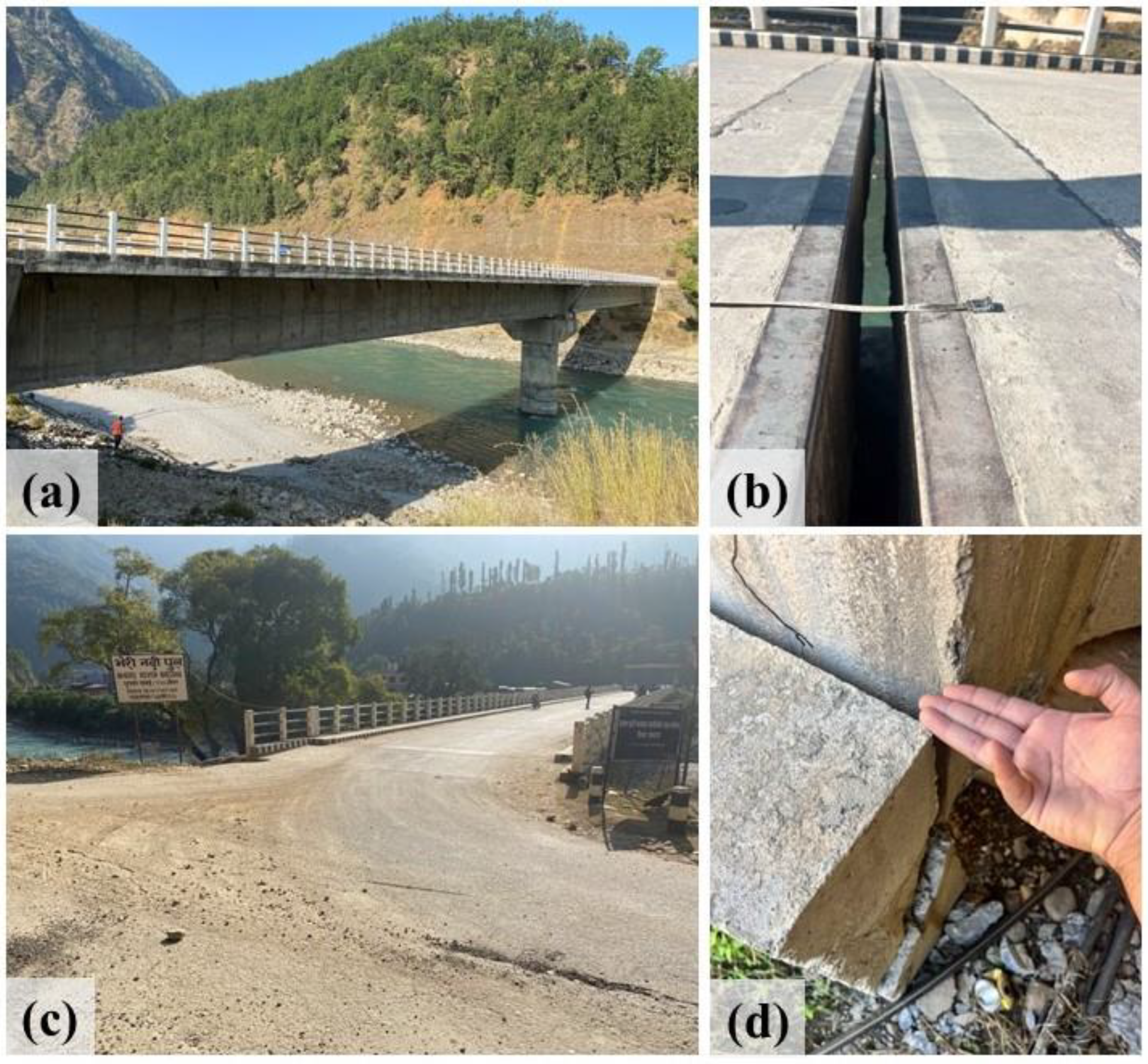
| AffectedDistricts | Total Building | Mud Bonded Bricks/Stone | Cement Bonded Bricks/Stone | Reinforced Cement Concrete with Pillars | Wooden Pillars | Other |
|---|---|---|---|---|---|---|
| Jajarkot | 33,566 | 32,042 | 882 | 498 | 123 | 21 |
| Rukum (West) | 37,290 | 33,886 | 1939 | 1380 | 59 | 26 |
| Salyan | 54,672 | 49,617 | 2816 | 2006 | 211 | 22 |
Disclaimer/Publisher’s Note: The statements, opinions and data contained in all publications are solely those of the individual author(s) and contributor(s) and not of MDPI and/or the editor(s). MDPI and/or the editor(s) disclaim responsibility for any injury to people or property resulting from any ideas, methods, instructions or products referred to in the content. |
© 2024 by the authors. Licensee MDPI, Basel, Switzerland. This article is an open access article distributed under the terms and conditions of the Creative Commons Attribution (CC BY) license (https://creativecommons.org/licenses/by/4.0/).
Share and Cite
Subedi, M.; KC, R.; Sharma, K.; Misra, J.; KC, A. Reconnaissance of the Effects of the MW5.7 (ML6.4) Jajarkot Nepal Earthquake of 3 November 2023, Post-Earthquake Responses, and Associated Lessons to Be Learned. Geosciences 2024, 14, 20. https://doi.org/10.3390/geosciences14010020
Subedi M, KC R, Sharma K, Misra J, KC A. Reconnaissance of the Effects of the MW5.7 (ML6.4) Jajarkot Nepal Earthquake of 3 November 2023, Post-Earthquake Responses, and Associated Lessons to Be Learned. Geosciences. 2024; 14(1):20. https://doi.org/10.3390/geosciences14010020
Chicago/Turabian StyleSubedi, Mandip, Rajan KC, Keshab Sharma, Jibendra Misra, and Apil KC. 2024. "Reconnaissance of the Effects of the MW5.7 (ML6.4) Jajarkot Nepal Earthquake of 3 November 2023, Post-Earthquake Responses, and Associated Lessons to Be Learned" Geosciences 14, no. 1: 20. https://doi.org/10.3390/geosciences14010020
APA StyleSubedi, M., KC, R., Sharma, K., Misra, J., & KC, A. (2024). Reconnaissance of the Effects of the MW5.7 (ML6.4) Jajarkot Nepal Earthquake of 3 November 2023, Post-Earthquake Responses, and Associated Lessons to Be Learned. Geosciences, 14(1), 20. https://doi.org/10.3390/geosciences14010020









